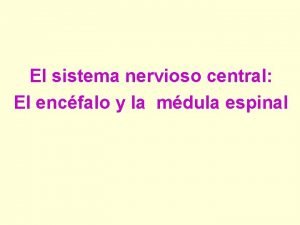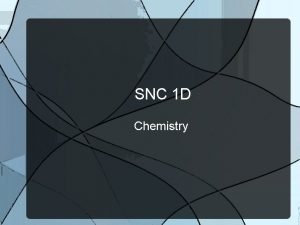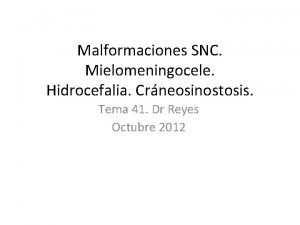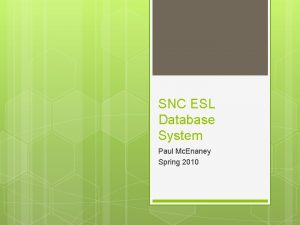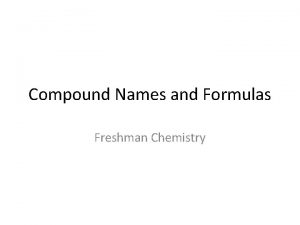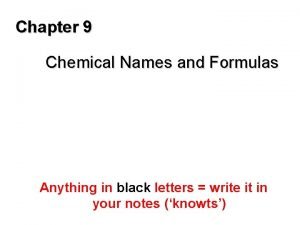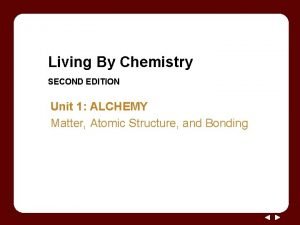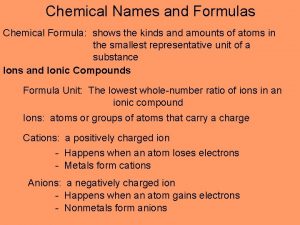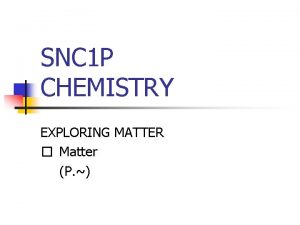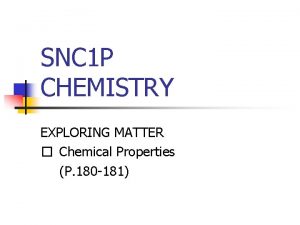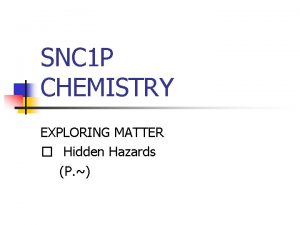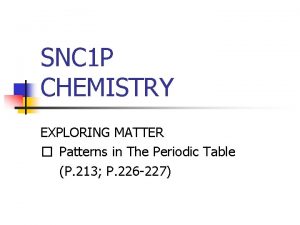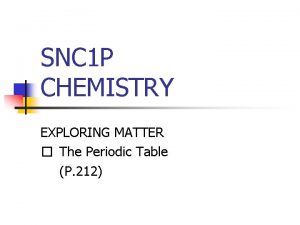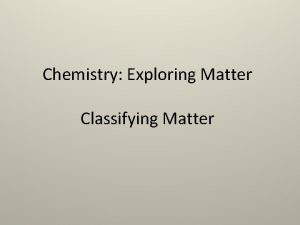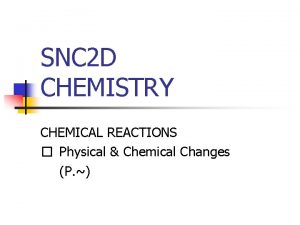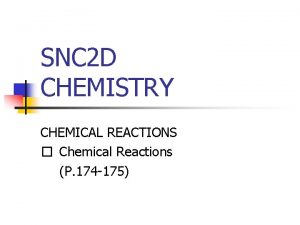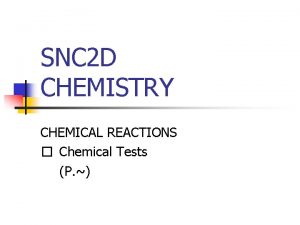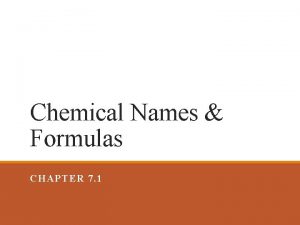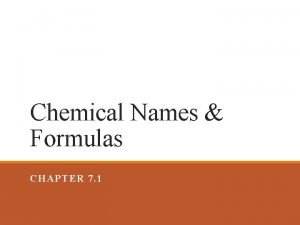SNC 1 P CHEMISTRY EXPLORING MATTER Chemical Names

















- Slides: 17

SNC 1 P CHEMISTRY EXPLORING MATTER � Chemical Names & Formulas (P. ~)

Chemical Names Like many substances, ionic and molecular compounds have both chemical names and common names. To name an ionic compound such as sodium chloride, write the name of the metal first: sodium. Then write the name of the non-metal and change its ending to “ide”: chloride. NOTE! This is just one rule for naming ionic compounds. Other ionic compounds have different rules for naming. December 29, 2021 1 PCHEM - Chemical Names & Formulas 1

Chemical Names PRACTICE 1. What are the (a) Ca. Cl 2 (b) Ca. O (c) Cu. Cl (d) KI (e) Ag. Cl December 29, 2021 chemical names of the following compounds? �used to melt ice calcium chloride �used in plaster calcium oxide �used to make red glass copper chloride �added to “iodized” table salt potassium iodide �used in photography silver chloride 1 PCHEM - Chemical Names & Formulas 2

Chemical Names To name a molecular compound prefixes like mono, di, tri, . . . are used to represent the number of each atom present in the molecule. For example, when carbon and oxygen combine you get the molecular compound: carbon dioxide (CO 2 ). NOTE! You will learn more about naming both ionic and molecular compounds in Grade 10. December 29, 2021 1 PCHEM - Chemical Names & Formulas 3

Chemical Names PRACTICE 2. What are the chemical names of the following compounds? (a) CO 2 �dry ice carbon dioxide (b) CH 4 �natural gas (methane) carbon tetrahydride (c) NH 3 �ammonia nitrogen trihydride (d) CO �a silent killer carbon monoxide (e) H 2 O �water dihydrogen monoxide December 29, 2021 1 PCHEM - Chemical Names & Formulas 4

Chemical Formulas Chemical formulas are used to represent compounds, but how do we know the proportions of each element in the compound? After performing many experiments, scientists discovered patterns in the ability of different elements to combine to form compounds. This ability is called the combining capacity and is similar to the number of connections or bonds that an atom can make. December 29, 2021 1 PCHEM - Chemical Names & Formulas 5

Chemical Formulas The combining capacity is also equal to the element’s ion charge which is indicated in the top right corner of the element’s square on the periodic table. Most elements have only one combining capacity. However, some elements, such as iron, nickel, and copper to name a few, have more than one combining capacity. NOTE! You will learn more about writing chemical formulas both ionic and molecular compounds in Grade 10. December 29, 2021 1 PCHEM - Chemical Names & Formulas 6

Chemical Formulas December 29, 2021 1 PCHEM - Chemical Names & Formulas 7

Chemical Formulas PRACTICE 3. The elements in group 18 do not have an ion charge. Why? they are the noble gases – they are stable and non-reactive December 29, 2021 1 PCHEM - Chemical Names & Formulas 8

Building Molecular Models Chemical formulas indicate how many atoms of each element there are in a molecule, but they do not convey any sense of the 3 D nature of molecules. As such, chemists use models to gain information about the shape of a molecule. The shape of the molecule is a good predictor of its properties. December 29, 2021 1 PCHEM - Chemical Names & Formulas 9

Building Molecular Models In these models, the atoms are held together by connections called bonds. The connections represent the electrons that “glue” or bond the atoms together. December 29, 2021 1 PCHEM - Chemical Names & Formulas 10

Building Molecular Models NOTE! The molecules can also be represented by drawings on paper called structural diagrams. In these diagrams, each atom is represented by its chemical symbol and each bond is represented by a straight line drawn between the symbols. December 29, 2021 1 PCHEM - Chemical Names & Formulas 11

Building Molecular Models STRUCTURAL DIAGRAM v pencil and paper drawing of a molecule NOTE! In some cases, more than one bond can exist between the same two atoms. December 29, 2021 1 PCHEM - Chemical Names & Formulas 12

Building Molecular Models As was discussed earlier, most elements form a fixed number of bonds – indicated by the ion charge – no more and no fewer. The table lists the number of bonds that each element will make. Element Symbol Colour # of Bonds hydrogen H white 1 chlorine Cl green 1 oxygen O red 2 sulphur* S yellow 2 nitrogen* N orange 3 carbon C black 4 NOTE! The coloured balls used in the model kits to represent sulphur and nitrogen actually have more holes than we need. The solution? Ignore the extra holes. December 29, 2021 1 PCHEM - Chemical Names & Formulas 13

Activity: Building Molecular Models The chemical formula shows the number and types of atoms in each molecule of a substance. But chemical formulas do not tell us how the atoms are arranged in a molecule. In this activity, you will use molecular model kits to build models of common molecules to see how they are put together. NOTE! There are two rules you must follow when building molecular models: � each molecule is complete when all the balls are connected in such a way that all the holes are filled, and � it is possible in some cases for more than one connection to exist between the same two atoms (i. e. a double bond or a triple bond). December 29, 2021 1 PCHEM - Chemical Names & Formulas 14

Activity: Building Molecular Models INSTRUCTIONS A. Copy the table on the next page onto a blank page (neatness counts). Be sure to leave enough room in the table to include sketches! B. Obtain a molecular model kit (you will be working in pairs). C. For each molecule: (a) build the molecule (b) have the teacher check it (c) sketch a structural diagram of the molecule (d) indicate whether the molecule is an element (E) or a compound (C) D. Submit your table when you are finished. December 29, 2021 1 PCHEM - Chemical Names & Formulas 15

Activity: Building Molecular Models Chemical Formula Sketch Common Name/Use H 2 hydrogen gas (fuel) Cl 2 chlorine gas (pool disinfectant) O 2 oxygen gas (breathing) N 2 nitrogen gas (cryogenics) HCl hydrogen chloride (stomach acid) H 2 O water (drinking) CH 4 methane (natural gas) NH 3 ammonia (cleaner) H 2 O 2 hydrogen peroxide (disinfectant) CO 2 carbon dioxide (puts out fire) C 2 H 2 acetylene (fuel) C 2 H 4 ? ? (used to make plastic) C 3 H 8 propane (fuel) December 29, 2021 1 PCHEM - Chemical Names & Formulas E/C? 16
 Chapter 9 chemical names and formulas answer key
Chapter 9 chemical names and formulas answer key Hhps octagon meaning
Hhps octagon meaning Snc y snp diferencias
Snc y snp diferencias Snc-1
Snc-1 Snc lajaa venissieux
Snc lajaa venissieux Società in nome collettivo
Società in nome collettivo Hidrocefalia pasiva
Hidrocefalia pasiva Paul mcenaney
Paul mcenaney Chemistry compound names
Chemistry compound names Bond angle
Bond angle Chapter 9 chemical names and formulas
Chapter 9 chemical names and formulas Dichlorine octoxide formula
Dichlorine octoxide formula A new language chemical names and symbols
A new language chemical names and symbols Naming compounds
Naming compounds Hg2o compound name
Hg2o compound name Classification of matter section 1 composition of matter
Classification of matter section 1 composition of matter Gray matter
Gray matter Classification of matter section 1 composition of matter
Classification of matter section 1 composition of matter


